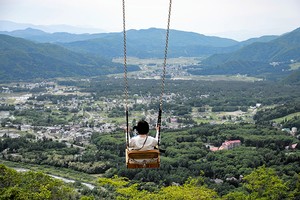THE ASSOCIATED PRESS
May 21, 2024 at 12:00 JST
 In this Dec. 8, 2010 file photo, snow-covered Mount Fuji, Japan's highest peak at 3,776-meters tall (12,385 feet), is seen from an airplane window.(AP Photo)
In this Dec. 8, 2010 file photo, snow-covered Mount Fuji, Japan's highest peak at 3,776-meters tall (12,385 feet), is seen from an airplane window.(AP Photo)
Those who want to climb one of the most popular trails on Japan’s iconic Mount Fuji will have to book a slot and pay a fee as crowds, littering and climbers who try to rush too fast to the summit cause safety and conservation concerns at the picturesque stratovolcano.
The new rules for the climbing season, starting July 1 to Sept. 10, apply for those hiking the Yoshida Trail on the Yamanashi side of the 3,776 meter- (nearly 12,300 feet-) high mountain that was designated a UNESCO World Cultural Heritage site in 2013.
Only 4,000 climbers will be allowed to enter the trail per day for a hiking fee of 2,000 yen (about $18). Of those slots, 3,000 will be available for online booking and the remaining 1,000 can be booked in person on the day of the climb, Yamanashi prefecture said in a statement via the Foreign Press Center of Japan on Monday. Hikers also have an option of donating an additional 1,000 yen (about $9) for conservation.
Climbers can book their slots via the Mount Fuji Climbing website, which is jointly run by the Environment Ministry and the mountain’s two home prefectures, Yamanashi and Shizuoka.
Mount Fuji is divided into 10 stations, and there are four “5th stations” halfway up the mountain from where the Yoshida, Fujinomiya, Subashiri, and Gotemba trails start to the top.
Under the new system, climbers must choose between a day hike or an overnight stay at the several available huts along the trail. The day of their climb, they are given a QR code to be scanned at the 5th station. Those who have not booked an overnight hut will be sent back down and not allowed to climb between 4 p.m. and 3 a.m., mainly to stop “bullet climbing,” or rushing to the summit without adequate rest, which authorities are worried puts lives at risk.
A symbol of Japan, the mountain called “Fujisan” used to be a place of pilgrimage. Today, it especially attracts hikers who climb to the summit to see the sunrise. But the tons of trash that’s left behind, including plastic bottles, food and even clothes, have become a major concern.
In a statement, Yamanashi Gov. Kotaro Nagasaki thanked people for their understanding and cooperation in helping conserve Mount Fuji.
Shizuoka Prefecture, southwest of Mount Fuji, where climbers can also access the mountain, has sought a voluntary 1,000-yen ($6.40) fee per climber since 2014 and is considering additional ways to balance tourism and environmental protection.
The number of Mount Fuji climbers during the season in 2023 totaled 221,322, according to the Environment Ministry. That is close to the pre-pandemic level and officials expect more visitors this year.
Just a few weeks ago, a town in Shizuoka began setting up a huge black screen on a sidewalk to block a view of Mount Fuji because tourists were crowding into the area to take photos with the mountain as a backdrop to a convenience store, a social media phenomenon known as “Mount Fuji Lawson” that has disrupted business, traffic and local life.
Overtourism has also become a growing issue at other popular tourist destinations such as Kyoto and Kamakura as foreign visitors have flocked to Japan in droves since the coronavirus pandemic restrictions were lifted, in part due to the weaker yen.
Last year, Japan had more than 25 million visitors, and the figures in 2024 are expected to surpass nearly 32 million, a record from 2019, according to the Japan National Tourism Organization.




















A peek through the music industry’s curtain at the producers who harnessed social media to help their idols go global.
A series based on diplomatic documents declassified by Japan’s Foreign Ministry
Here is a collection of first-hand accounts by “hibakusha” atomic bomb survivors.
Cooking experts, chefs and others involved in the field of food introduce their special recipes intertwined with their paths in life.
A series about Japanese-Americans and their memories of World War II